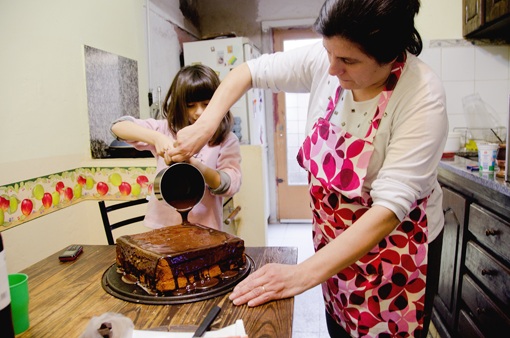Is there an Argentine middle-class dream?” When they’re asked that question, Guillermo Iacoboni, 36, and his wife Raquel, 38, look at each other quizzically across the kitchen table as their daughters Julieta, 7, and Guillermina, 11, sit in their room playing on their computer.
“I guess it would be owning your own house,” Guillermo answers.
“We both grew up middle class,” Raquel says. “Even though my dad had 10 children, and Guillermo’s mother was widowed, when Guillermo was one year old, our parents could afford their own houses. Now? Impossible.”
The couple met in college in La Plata, a small city 70 kilometers (43 miles) from Buenos Aires, where they still live. When their youngest child, Julieta, was born, the couple was financially secure enough from Guillermo’s earnings as a banker to buy their own house—a key indicator of their continued middle-class status.
But can they weather the storms in Argentina’s economy well enough to stay there?
Over the past decade, the fortune of Argentina’s middle class has been in flux. This year, the Economic Commission for Latin America and the Caribbean reported that while Latin America’s middle class has collectively increased by 56 million people since 1999, Argentina’s middle class dropped from 56 to 52 percent of the country’s total population. Declining levels of homeowners—from 70 to 66 percent between 1999 and 2009, according to the Inter-American Development Bank—help explain why.
Guillermo’s monthly salary at the Caja de Ahorro y Seguro, where he’s worked for the past 15 years, is 8,200 pesos ($1,700). That puts the Iacoboni household earnings (Raquel is a homemaker) at about 3,000 pesos ($640) above Argentina’s per capita GDP.
The trappings of the Iacoboni home befit the family’s middle-class aspirations. The kitchen boasts an oven and a large refrigerator. All four rooms have televisions, where Raquel watches reruns of the popular U.S. sitcom Sex and the City and the girls devour reality shows such as What Not to Wear and The Biggest Loser.
Achieving financial security has not been easy against the backdrop of Argentina’s economic instability. Skyrocketing inflation in the 1970s and 1980s was followed by the economic crisis of 2001, when the government unpegged the peso from the dollar and Argentines suddenly found their savings slashed by two-thirds.
Guillermina, the Iacoboni’s eldest daughter, was born during the 2001 crisis. At the time, Guillermo was earning the equivalent of just $900 a month—which left only $50 for savings and extra expenses after bills were paid. Diapers, baby formula and medicines seemed out of reach.
By 2003, the economy had recovered significantly. The election of the late President Néstor Kirchner ushered in four years of impressive export-led growth, averaging 9 percent a year. Cristina Fernández de Kirchner, Nestor’s widow and successor as president, has continued such growth—but at the cost of sky-high inflation, estimated between 25 and 35 percent. As investor confidence has flagged, Fernández de Kirchner has implemented drastic policies to stem capital flight, many of which have enraged the middle class, sending some Argentines to the streets to protest.
The Iacobonis count themselves lucky to have purchased their house when they did. With the current inflation-pumped home prices, they believe they couldn’t have afforded a house or qualified for a mortgage today. Since 2001, mortgage lending has shrunk markedly; last year, just 6.6 percent of home purchases were funded by mortgages.1
But inflation and currency controls have forced the Iacobonis to give up or postpone some of the “luxuries” of middle-class status, like international travel and car ownership—and inflation has prevented them from contributing to a savings account.
Unfortunately, there’s no immediate end in sight. While the Argentine government insists inflation is steady at 10 percent, the Centro de Investigación en Finanzas at the Universidad Torcuato Di Tella puts inflation at 30 percent. Argentines have privately mocked a report recently produced by the government statistics agency INDEC, claiming that an Argentine family could eat for the equivalent of 6 pesos ($1.30) a day per person. The average carton of six eggs alone costs about 5.50 pesos and a loaf of bread costs at least 10 pesos.
“Where do Kirchner’s officials buy their food? I’d like to live in the same country they do,” Guillermo recently posted on his Facebook profile.
The Iacobonis fear that until another candidate occupies the Casa Rosada, Argentina’s middle class will continue to contract and their living standards will continue to decline. While they no longer worry about making ends meet, Guillermo and Raquel fret that someday Julieta and Guillermina might have to.
The girls have big dreams. Guillermina wants to decamp to Paris and become a fashion designer like those she sees on Project Runway. Julieta wants to become a sculptor. Their parents are just hoping that by the time their daughters grow up, the “Argentine middle-class dream” won’t be out of reach.





